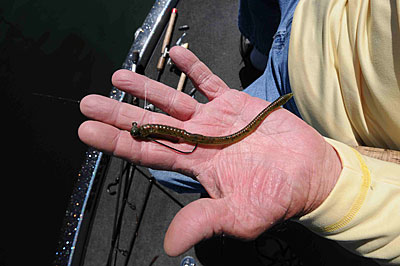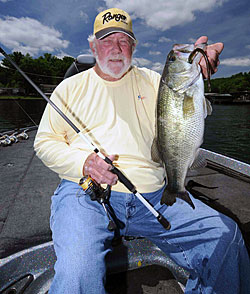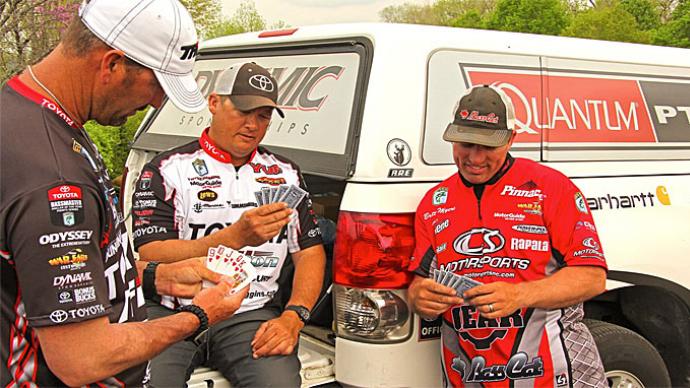
Many touring pros have dubbed it shaky head fishing, but Guido Hibdon likes to call it jig worm fishing.
The Godfather of Finesse Fishing’s label best describes this tactic since it requires using a jighead and a plastic worm. Shaky head derives from shaking the jig and worm to trigger strikes, but Hibdon doesn’t always need to shake his jig worm to catch bass.
“Every day will tell you a different story on how to work it,” Hibdon says. “I hop it a little bit. Sometimes I throw it out there, crank it real slow, and let it bump the bottom now and then. The next time I might have to pick it up and pull it a little bit and hop it once or twice.”
Taking a break from the FLW Tour, Hibdon has returned to guiding on his home waters of Lake of the Ozarks. During a recent outing with Hibdon, I got a chance to learn some of the legendary pro’s tricks for catching finicky bass on a jig worm. Despite facing some tough conditions (calm bluebird skies and bass recuperating from the spawn), we still managed to catch 15 keepers, with our best five fish probably weighing around 15 pounds. Almost all the fish we caught that day was on a hop-and-fall presentation.
Hibdon frequently sets up his clients with a jig worm. “A jig worm is one of those deals that anybody can do,” Hibdon says. “It is the simplest fishing that anybody can do. I get a big kick out of it.”
Hibdon’s clients get a big kick out of it because it catches lots of fish and coaxes big bass into biting. “You bet it will, “Hibdon claims. “The biggest fish I have seen this year a guy caught out of the back of my boat on it. He had an 8-pound, 6-ounce fish that he caught on 8-pound line with a jig worm on one of my rods. If you took his best five fish, he would have ended up with 26 or 27 pounds.”
Using a light jighead is the key to jig worm fishing. “The lighter you can keep the head, the better off you are,” says Hibdon. The former Bassmaster Classic champ uses 1/16-or 1/8-ounce jigheads for most of his jig worm applications, but he will upgrade to a 1/4-ounce head on windy days to prevent his line from bowing.
Pouring his jigheads allows Hibdon to make models with different size hooks. So when he fishes 4-inch finesse worms, the veteran guide opts for a jighead with a 3/0 or 4/0 hook and switches to a model with a 5/0 hook for 6-inch or larger trick worms. “You don’t have to use a small bait to do it,” says Hibdon, who matches his jighead with a Zoom Magnum Trick Worm during summer and fall.

Before rigging the worm on the jig, Hibdon slightly pushes down on the bend of the hook with a pair of pliers, which helps the worm lay straighter on the hook and assures a better hook set. The key to rigging the combo is ensuring the worm sits straight on the hook. “If the worm has a little crook in it, the line will get twisted all the time,” Hibdon warns. When rigged correctly, the hook's point should be barely under the skin of the worm body to make the combo weedless.
Hibdon ties his jighead with a Palomar knot onto an 8-foot leader line of Berkley Trilene 100% Fluorocarbon, followed by tying the main line of yellow 10-pound Trilene braid with a Double Uni or Albright knot. “I don’t use straight fluorocarbon because I can’t see it, and if I use anything heavier than 8 pounds on the (spinning) reel, you can’t keep it on the reel,” he says. “It just spins off too easily (and will create a tangled mess).”
The longtime FLW Tour pro prefers the yellow braid to see the line easier, but Hibdon adds the fluorocarbon leader to prevent fish from detecting his line. “I get paranoid knowing fish can see that yellow line, so that determines how long I make my leader,” says Hibdon. He lengthens his leader to 10 to 12 feet in the clearest water. In dirty water, he still throws the same fluoro-braid combination but opts for a leader of 12- to 15-pound fluorocarbon and a main line of 15-pound braid.
Hibdon recommends throwing the jig worm on a 7-foot medium-action spinning rod with a strong backbone yet a fast tip for casting accuracy and distance. He favors using a Lew’s spinning reel with a medium size spool.
BassResource may receive a portion of revenues if you make a purchase using a link above.




